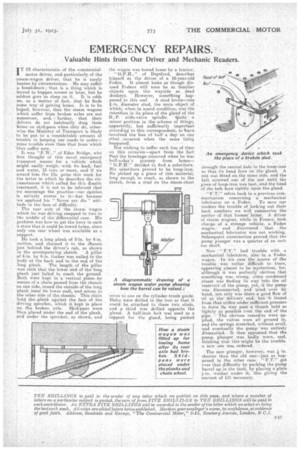EMERGENCY REPAIRS.
Page 29

If you've noticed an error in this article please click here to report it so we can fix it.
Valuable Hints from Our Driver, and Mechanic Readers.
TT IS characteristic of the commercial' . motor driver, and particularly of the steam-wagon driver,. that he is rarely beaten by circumstances. 'He may suffer a
breakdown;. that is a thing Which is bound to happen sooner or later, but he
seldom goes to sleep on it. It is odds on, as a matter of fact, that he finds some way of getting home.It is to be boped, however, that the steam wagons which suffer fiqm broken axles are not numerous, and, ,:further, • that their drivers do not habitually drag them 'home on skid-pans when tifey do, otherwise the Ministry of.. Transport is likely to be put to a considehable amount of trbuble in keeping our roads. in order. pore trouble even than that fromwhich
they suffer new. . • ,••
• It-was "T.W.," of Eden Bridge, who first thought of this novel emergenc3l. transport. means for a vehicle which might easily weigh,with its load, fuel and water, 13 thus or more, au& if we award -him the 15s. prize this week for the letter in which he describes the cir: curastanc.e.'s which called for this drastic treatment, it is not to be inferred that we encourage the practice our opinion.
is entirely averse to ' because we applaud his " Never say die " atti tude in the la,co of difficulty. .
" ?he rear axle of the steam wagon which he was driving snapped in two in the middle of the differential case. His problem was how to get the lorry in such_ 'a state that it could be towed home, since only one rear wheel Was available as a support. .
He took a long plank of Din, by 4-in. section, and chained it to the c'hassi.n just behind: the driver's cab, as shown in the accompanying sketch. A pillar of 4-in. by 4-in. timber was nailed to the liticly at the back and-to the end of the long plank. The length. of the pillar was such that, the loiver end of the long plank just failed to reach the• ground. Both were kept-in -a-vertical. plane-lay means .of a chain passed from the chassis on One side, round the outside of the long 'plank (near its lower end), and acroSs the other side of the chassis: This chain held the-plank against the face of the driving sprocket, which it kept in place ea the broken, axle. Skid-pans were 'then placed under the end of the-plank, and underthe Sprocket, as shown, and
the wagon was towed home bya tractor.
" G-.P.H.,". of Deptford, describes 'himself as the driver of a 16-Year-old Foden. It almost looks as though dis.used Fodens will soon be an familiar objects upon. the wayside as dead donkeys. However., sometting happened to this one A stud broke—One
dianniter stud, the main objeCt of which, when in sound condition, was the retention in its place Of the gland of the 13.-1). slide-valve spindle. Quite in minor ponition in the, scheme of things, apparently, but suffiCiently important according to this correspondent, to 'have -involved the loss Of half a -day-1oreOtte other . accanion when the" same thing
-happened. .
. Not wishing to suffer such loss of time ou this occasion--apart from the fact that the breakage occurred when he was half-a-day's journey from home" decided to find a substitute, His substitute proved to be hoop-iron'. Tie picked up a piece Of this material, long enough to reach, an shown in the sketch, from a stud on the steam-chest 'throinth the centrathole in the hoop-iron so that its bead bore on the gland. A nut was fitted on, the canto side, and the belt screwed out of the nut until the piece of hoop-iron was taut, and the head of the bolt bore tightly upon the gland, • "FT." refers back to a previous communication concerning a mechanical
lubricator. on a Fader'. To save our readers the trouble Of looking, out their back numbers we will summarize the matter cif that former_ letter. A driver of steam wagons, while in France-, took charge of a_ strange vOiicle, a • leoden wagon,and discovered that the mechanical lubricator was not working. Subsequent examination proved that the pump plunger was :a quarter Of an ineh
too short. •
• NOW "F.T." hadtrouble with a mechanical lubricator, also in a Yoden wagon. In his case the source of the trouble . was rather difficult to' trace, appearing almost to be mysterious, foe, although it was perfectlyobvious that. something was wrong, since condensed ,steam was finding its way into the oil reservoir of the pump, yet,. if the pump -was disconnected, and tried over by 'hand, not only was there a good flow of nil 'at the-delivery ' end; .-but "-it iisiied from tihat"prifice under sufficientpressnre to force its Way past a thumb_ held as 'tightly as poSsible ever the end:. of' the pipe. The obvious remedies were applied, the valves were all ksound in, and the springs stretched, without avail, -and eventually the pump 'was entirely dismantled. It then appearedthat the pump plunger was badly worn,' and, thinking that this might be the trouble. a new one was ordered.
The new plunger, however, was 4shorter than the old one—just as happened in' the other case. "F.W! . got over that difficulty by packing the pump barrel up in the tank, by placing a plain ivasher under it, this giving the amount of lift necessary.






























